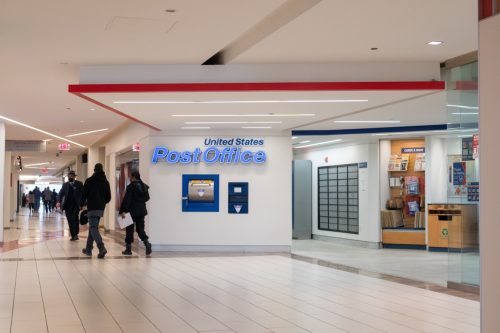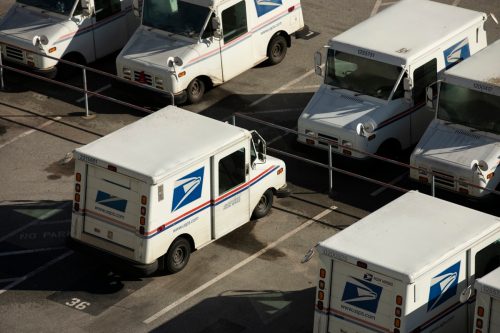USPS Is Moving Ahead With Controversial Changes: “We Are Not Pausing”

Most of us trust the U.S. Postal Service (USPS) to get our mail from one place to another without considering how complicated that process can be. The USPS operates through a complex system of processing and distribution facilities to move mail throughout the country. And over the last few years, the process has been undergoing some serious changes, as Postmaster General Louis DeJoy works through his decade-long USPS overhaul, Delivering for America (DFA). With this plan, DeJoy is attempting to modernize the postal network by shifting the movement of mail and packages—something not everyone is on board with. But that doesn’t seem to be stopping the Postal Service, as the agency has announced plans to move ahead despite major opposition. Read on to learn about the changes the USPS is “not pausing.”
RELATED: 6 Major Changes Postmaster General Louis DeJoy Has Made to the USPS.
The USPS is trying to consolidate its network.

A major part of DeJoy’s DFA plan is centered around consolidating the nation’s postal network. As the USPS Office of Inspector General (OIG) explains, this new network will feature three mail types of facilities: Regional Processing and Distribution Centers (RPDCs), Local Processing Centers (LPCs), and Sorting and Delivery Centers (S&DCs).
Under DFA, the USPS is planning to convert many postal processing and distribution facilities in smaller communities into LPCs, reducing some of their functions and transferring them to more centralized RPDCs. The agency is looking to have 60 RPDCs across the continental U.S., with each of these 60 regions being supported by a number of different LPCs and S&DCs.
Overall, the Postal Service believes that this consolidation effort will lead to “cost savings, reliable service, renewed relevance, and longevity” for the agency.
RELATED: USPS Worker Says Current Delays Are “The Worst I’ve Ever Seen.”
Lawmakers have asked the agency to pause these efforts.

Not everyone is certain that this consolidation initiative is a good thing, however. A bipartisan group of 26 U.S. senators sent a letter to the USPS on May 8 calling on the agency to take a pause from making any further changes to its processing and delivery network until the Postal Regulatory Commission (PRC) could examine the “potential impacts of these changes.”
The letter was led by Michigan Senator Gary Peters, who serves as chairman of the Senate Homeland Security and Governmental Affairs Committee.
“In regions where USPS has implemented significant changes, on-time mail delivery has declined. In addition, it is not clear these changes will improve efficiency or costs,” the letter reads. “Despite these concerns, USPS has moved forward with announcing and approving additional facility changes across the country. The nature of these changes creates concerns that local and rural service could be degraded.”
The senators said the USPS should request a comprehensive advisory opinion from the PRC and “pause all changes, including administrative approvals and on-the-ground changes, until the PRC completes this study and USPS incorporates the results.”
“While USPS claims these changes overall will improve service while reducing costs, there is evidence to the contrary in locations where USPS has implemented changes so far,” the senators also noted in their letter.
RELATED: USPS Slammed for “Unsustainable” Price Hikes as Lawmakers Demand Change.
The USPS agreed to halt some of its plans.

Just one day after the senators sent their letter, DeJoy responded to address their concerns. In his May 9 letter addressed to Senator Peters, the Postmaster General said he would “agree to pause” some of the changes planned for the agency’s processing operations until at least Jan. 1, 2025.
“Even then, we will not advance these efforts without advising you of our plans to do so, and then only at a moderated pace of implementation,” DeJoy wrote. “I will also continue to consider whether we should seek an advisory opinion from the PRC as a discretionary matter on our part.”
But DeJoy now says they’ll be moving ahead with certain controversial changes.

It seems the USPS isn’t putting a stop to all its consolidation efforts. On May 20, DeJoy sent another letter to Peters, furthering clarifying the agency’s “continued activity on regional processing and distribution centers, sorting and delivery centers, and local processing centers.”
According to DeJoy, the USPS is pausing the movement of processing operations associated with Mail Processing Facility Reviews (MPFRs) for the rest of this year. So far, the agency has reviewed nearly 60 facilities to determine whether they should move some of their mail operations and volume to regional centers. But in response to the senators’ concerns, DeJoy has agreed not to implement operational transfers decided by MPFRs until the beginning of next year, at the earliest.
At the same time, the USPS is continuing with other consolidation efforts in 2024. These include the completion of several RPDCs and LPCs that have already been initiated. Currently, there are 13 RPDC projects underway and 20 LPC projects underway, according to DeJoy’s letter.
“Nearly all these RPDC and LPC facilities for which we are not pausing implementation are existing and operating,” DeJoy explained. “The work we are engaging in with these initiatives is to catch up on 20 years of deferred maintenance, upgrade 30-year-old technology, install modern sortation equipment and rearrange our production floor layout to logically accommodate the difference between the size of a letter and the size of a package.”
In a separate statement accompanying the new letter, the Postmaster General further defended the changes he is not planning to pause as part of his 10-year overhaul.
“Our Delivering for America plan initiatives are breathing new life into the U.S. Postal Service. Despite evident progress, it’s clear that these efforts should have commenced more than a decade ago,” he said. “The need for swift and comprehensive transformation in the Postal Service is undeniable. We remain fully committed to this transformation with the goal of continuously improving service performance for the American people—all while being financially self-sustainable.”